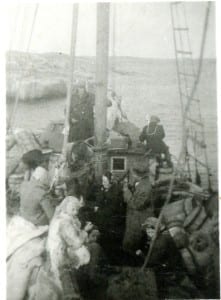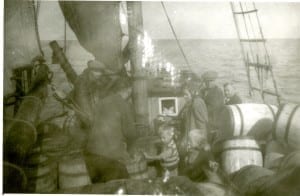Chapter 3: My family fled as refugees
Click here to access BBC Estonia country profile >

Boat on which my father and grandfather and other refugees made it across the Baltic Sea in September 1944 during the Second World War. Other family members travelled across the Baltic on a larger vessel.
Chapter 3 of my Autobiography Story is concerned with my family’s refuge story – which as it turns out, is a story about how I ended up in Canada and among other things helps to explain my interest in military history.
A couple of previous posts introduce the story; Part 3 will entail additions and elaborations of the theme:

Boat on which my father and grandfather made it across the Baltic Sea in September 1944. My grandfather is on the right. He passed away in Sweden a decade later.
One of the great disappointments of my mother’s life, as she made a point of asserting in her above-noted life story, which is beautifully written and highly evocative, was that as her son I did not turn out to be a true Estonian, as she defined the term. Indeed, I did not. From my own point of view, her disappointment underlines the limitations of nationalism.
The needs and interests of the individual can readily come into conflict with the needs and interests of nationalism.
I much enjoy being Estonian, as I define the term. Estonian was my first language; as Estonians in Estonia and Canada have remarked from time to time, in the course of many years, my spoken Estonian has an unusual quality, for a person who has grown up outside of Estonia, in my case in Canada. That is to say, I speak Estonian without an Estonian accent.
As well, one of the interesting features of my speech is that my way of speaking Estonian is reminiscent of the Estonian language that people spoke in the 1940s. That makes sense, as it was in the 1940s that I learned to speak the language. When I was growing up and for the rest of my life while my parents were still alive, I always spoke with my parents in Estonian.
I speak an unusual, retro form of Estonian, without a western accent.
Another previous post is entitled:
Soviets deported over 7,000 women, children, and elderly people from Estonia on June 14 to 17, 1941
Sense making takes many forms
Among my favourite recent books, with regard to the sense making project as it relates to my family’s refuge experiences, are Wall Flower (2015) and The Age of Selfishness (2015).
Wall Flower (2015)
Wall Flower: A life on the German Border (2015)
A blurb for the book at the Toronto Public Library website reads:
In August 1961, seventeen-year-old Rita Kuczynski was living with her grandmother and studying piano at a conservatory in West Berlin. Caught in East Berlin by the rise of the Berlin Wall while on a summer visit to her parents, she found herself trapped behind the Iron Curtain for the next twenty-eight years. Kuczynski’s fascinating memoir relates her experiences of life in East Germany as a student, a fledgling academic philosopher, an independent writer, and, above all, as a woman. Though she was never a true believer in Communism, Rita gained entry into the circles of the East German intellectual elite through her husband Thomas Kuczynski. There, in the privileged world that she calls “the gardens of the nomenklatura,” she saw first-hand the contradictions at the heart of life for the East German intelligentsia. Published in English for the very first time twenty-six years after the fall of the Berlin Wall, Wall Flower offers a rare–and critical–look at life among the East German elite. Told with wry wit and considerable candor, Kuczynski’s story offers a fascinating perspective on the rise and fall of East Germany.
[End of text]
Comment: This is a beautifully written study of life within the higher reaches of East Germany society in the years prior to the fall of the Berlin Wall.
The Age of Selfishness (2015)
The Age of Selfishness: Ayn Rand, Morality, and the Financial Crisis (2015)
A blurb for the book at the Toronto Public Library website notes:
Tracing the emergence of Ayn Rand’s philosophy of objectivism in the 1940s to her present-day influence, Darryl Cunningham’s latest work of graphic-nonfiction investigation leads readers to the heart of the global financial crisis of 2008. Cunningham uses Rand’s biography to illuminate the policies that led to the economic crash in the U.S. and in Europe, and how her philosophy continues to affect today’s politics and policies, starting with her most noted disciple, economist Alan Greenspan (former chairman of the Federal Reserve). Cunningham also shows how right-wing conservatives, libertarians, and the Tea Party movement have co-opted Rand’s teachings (and inherent contradictions) to promote personal gain and profit at the expense of the middle class. Tackling the complexities of economics by distilling them down to a series of concepts accessible to all age groups, Cunningham ultimately delivers a devastating analysis of our current economic world.
[End of text]
Comment: As Darryl Cunningham notes, in the above-noted graphic non-fiction historical overview, the subject of the study grew up in Soviet Russia – and in her life’s work ended up retaining and demonstrating elements of a Soviet mindset.
She was convinced that she was rebelling in totality against the Soviet mindset, but what she was rebelling against was expressed within the totalitarian framework that was part of her early Soviet-childhood sense making processes.
Such events happen frequently, in my observation.
Totalitarianism in its many forms, the mindsets of true believers in their many forms, populist political worldviews, propaganda, and in some cases public relations in its many forms, share a common characteristic – namely, the perspective that evidence and facts can be conveniently ignored, as they get in the way of the story, of the frame, and of the framing process.
It is also a feature of history that, in the end, the evidence does at times, and in many cases after many generations of people have come and gone, make its presence known. To state the matter another way, from time to time, reality obtrudes.
First Nations peoples
My sense is that First Nations peoples in Canada have in many cases ended up as refugees and deportees. In this context, an Aug. 20, 2016 CBC article is entitled: “Sayisi Dene found ‘utopia’ with 5-day dogsled escape to Tadoule Lake: Defying the government to flee death, destruction and ‘clutches of evil’ at Dene Village.”
A march 28, 2017 CBC article (referring to a short documentary) is entitled: “Peace River Rising: Is there a connection between violence against Indigenous women and violence against the land?”

Leave a Reply
Want to join the discussion?Feel free to contribute!